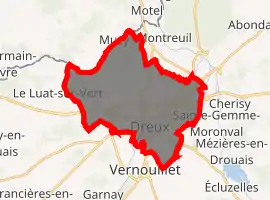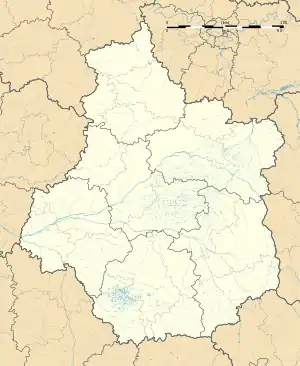Dreux
Dreux (French pronunciation: [dʁø]) is a commune in the Eure-et-Loir department in northern France.
Dreux | |
|---|---|
Subprefecture and commune | |
 Saint-Pierre church | |
.svg.png.webp) Coat of arms | |
Location of Dreux 
| |
 Dreux  Dreux | |
| Coordinates: 48°44′14″N 1°21′59″E | |
| Country | France |
| Region | Centre-Val de Loire |
| Department | Eure-et-Loir |
| Arrondissement | Dreux |
| Canton | Dreux-1 and 2 |
| Intercommunality | Drouais |
| Government | |
| • Mayor (2020–2026) | Pierre-Frédéric Billet[1] |
| Area 1 | 24.27 km2 (9.37 sq mi) |
| Population (2017-01-01)[2] | 31,044 |
| • Density | 1,300/km2 (3,300/sq mi) |
| Time zone | UTC+01:00 (CET) |
| • Summer (DST) | UTC+02:00 (CEST) |
| INSEE/Postal code | 28134 /28100 |
| Elevation | 75–139 m (246–456 ft) |
| 1 French Land Register data, which excludes lakes, ponds, glaciers > 1 km2 (0.386 sq mi or 247 acres) and river estuaries. | |
History
Dreux was known in ancient times as Durocassium, the capital of the Durocasses Celtic tribe. Despite the legend, its name was not related with Druids. The Romans established here a fortified camp known as Castrum Drocas.
In the Middle Ages, Dreux was the centre of the County of Dreux. The first count of Dreux was Robert, the son of King Louis the Fat. The first large battle of the French Wars of Religion occurred at Dreux, on 19 December 1562, resulting in a hard-fought victory for the Catholic forces of the duc de Montmorency.
In October 1983, the Front National won 55% of the vote in the second round of elections for the city council of Dreux, in one of its first significant electoral victories.[3]
Population
|
|
Sights
Chapelle royale de Dreux
In 1775, the lands of the comté de Dreux had been given to the Louis Jean Marie de Bourbon, duc de Penthièvre by his cousin Louis XVI. In 1783, the duke sold his domain of Rambouillet to Louis XVI. On 25 November of that year, in a long religious procession, Penthièvre transferred the nine caskets containing the remains of his parents, the Louis-Alexandre de Bourbon, comte de Toulouse and Marie Victoire de Noailles, comtesse de Toulouse, his wife, Marie Thérèse Félicité d'Este, Princess of Modène, and six of their seven children, from the small medieval village church next to the castle in Rambouillet, to the chapel of the Collégiale Saint-Étienne de Dreux.[4] The duc de Penthièvre died in March 1793 and his body was laid to rest in the crypt beside his parents. On 21 November of that same year, in the midst of the French Revolution, a mob desecrated the crypt and threw the ten bodies in a mass grave in the Chanoines cemetery of the Collégiale Saint-Étienne. In 1816, the duc de Penthièvre's daughter, Louise Marie Adélaïde de Bourbon, duchesse d'Orléans, had a new chapel built on the site of the mass grave of the Chanoines cemetery, as the final resting place for her family. In 1830, Louis-Philippe I, King of the French, son of the duchesse d'Orléans, embellished the chapel which was renamed Chapelle royale de Dreux, now the necropolis of the Orléans royal family.
Other sights
- Renaissance Château d'Anet
- Hôtel de Montulé (16th century)
- Pavilion of Louis XVI
- Hôtel de Salvat-Duhalde (18th century)
Personalities
Dreux was the birthplace of:
- Kalifa Cissé, footballer
- Martin Pierre d'Alvimare (1772–1839), composer and harpist
- Siraba Dembélé, handball player
- Abdou Dieye, footballer
- Louis Victor Dubois (1837–1914), wine merchant and politician
- Rémi Gounelle (1967-), Protestant theologian
- Marouan Kechrid, basketball player
- Yannick Lesourd, athlete
- Antoine Godeau (1605–1672), bishop, poet and exegete. He is now known for his work of criticism Discours de la poésie chrétienne from 1633.
- Jean Rotrou (1609–1650), poet and tragedian
- Jean-Louis-Auguste Loiseleur-Deslongchamps (1774–1849), botanist
- Charles Delescluze (1809–1871), journalist and military commander of the Paris Commune
- Adrien Trebel (1991-), footballer
- Eddie London (1956–), singer
- François-André Danican Philidor (1726–1795), musician and chess player
- Guerschon Yabusele, basketball player
Twin towns - sister cities
Dreux is twinned with:[5]
References
- "Répertoire national des élus: les maires". data.gouv.fr, Plateforme ouverte des données publiques françaises (in French). 2 December 2020. Retrieved 11 December 2020.
- "Populations légales 2017". INSEE. Retrieved 6 January 2020.
- Gaspard, Françoise (1995). A Small City in France. Harvard University Press. ISBN 0-674-81096-1. Retrieved 5 May 2017.
- G. Lenotre, Le Château de Rambouillet, six siècles d'histoire, Calmann-Lévy, Paris, 1930, reprint: Denoël, Paris, 1984, (215 pages), chapter 5: Le prince des pauvres, pp. 78–79
- "Les villes jumelées". dreux.com (in French). Dreux. Retrieved 22 November 2019.
External links
| Wikimedia Commons has media related to Dreux. |
- City council website (in French)
- Tourist office website
- Personal website about Dreux (in French)